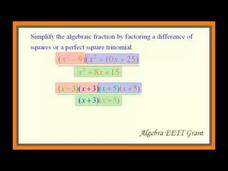Curated OER
Finding the 100th Term in a Sequence
The example problem is this video has a sequence of numbers that decrease by a fixed amount with each iteration, and one needs to find the 100th number in the sequence. Sal shows the listener how to find the pattern between the number...
Curated OER
How Do You Find the Common Difference in a Sequence?
Briefly show your class or individual learners how to find the common difference in an arithmetic sequence. A quick and simple video, this resource should guide pupils toward understanding the concept of common difference. Appropriate...
Curated OER
How Do You Find the Common Difference in a Sequence?
Briefly show your class or individual learners how to find the common difference in an arithmetic sequence. A quick and simple video, this resource should guide pupils toward understanding the concept of common difference. Appropriate...
Curated OER
Equations of Sequence Patterns
An example of writing an algebraic equation of the pattern of blocks that grows at each iteration is shown in this video. Sal shows how to find the pattern by looking at the iteration number and number of blocks. He then continues this...
Curated OER
Equations of Sequence Patterns
An example of writing an algebraic equation of the pattern of blocks that grows at each iteration is shown in this video. Sal shows how to find the pattern by looking at the iteration number and number of blocks. He then continues this...
Khan Academy
Patterns in Sequences 2
This video looks again at finding the algebraic pattern in sequences. In the example, we are looking at a figure where a number of toothpicks (or lines) are added each time, and you need to find how many toothpicks will be in the 50th...
Curated OER
Patterns in Sequences 2
This video looks again at finding the algebraic pattern in sequences. In the example, we are looking at a figure where a number of toothpicks (or lines) are added each time, and you need to find how many toothpicks will be in the 50th...
Curated OER
How Do You Find the Next Terms in an Arithmetic Sequence?
Common difference? Sounds like an oxymoron. It's a math term used to describe a pattern that may occur between a series of numbers. Watch this video and the instructor will explain what the term means as it is applied to an arithmetic...
Calculus Expert
How to Find the Inverse of a Function
Watch a function stand on its head. Reflect a function to create its inverse and then find the inverse equation algebraically. An instructional video demonstrates how to connect the graphical and algebraic process.
Curated OER
Where Does the Formula for a Term in an Arithmetic Sequence Come From?
There is a formula to find the nth term in an arithematic sequence. But first, the instructor in the video will go through several steps and lots of explanations about how to get that formula. Watch and listen carefully. And then maybe,...
TED-Ed
Fractals and the Art of Roughness
Roughness is everywhere, contributing to the incredible complexity of the world around us. This complexity, however, is not without it's own unique sense of order. Join world-renown mathematician Benoit Mandelbrot as he looks at numerous...
National Education Association
Simplify Expressions by Factoring
Got that factoring thing down? Time to apply it! A helpful video explains the process of simplifying a rational expression, showing pupils how to factor a majority of expressions using special patterns. Here is a great way to begin the...
Brightstorm
Introduction to Sequences
Finding patterns—seems easy enough. High schoolers learn the definition of a sequence in a concept video. Four problem videos then cover finding a particular term of a sequence given an explicit formula and identifying arithmetic and...
Curated OER
What's a Scatter Plot?
Scatter plots refer to a graph of given data. Scatter plots offer a way to look at information and allows the observer to analyze and interpret possible meanings and trends of the given data. Predictions can often be made based on the...
Curated OER
What's an Arithmetic Sequence?
2, 4, 6, 8, who do we appreciate? Do the numbers in this sequence make it an arithmetic sequence? Watch this video and find out.
Curated OER
What's an Arithmetic Sequence?
2, 4, 6, 8, who do we appreciate? Do the numbers in this sequence make it an arithmetic sequence? Watch this video and find out.
Curated OER
Special Polynomials Products 1
Some polynomials, when multiplied, result in a special product. Sal uses the distributive property to demonstrate the multiplication process. He then explains why some polynomials cannot be completely simplified.
Curated OER
What Does it Mean To Have No Correlation?
What does it mean when a scatter plot graph shows that there is no correlation? Does it have something to do with the slope of the line of fit? Yes, it certainly does have to do with the line of fit. If the slope of the line is zero,...
Curated OER
Factoring the Difference of Squares
Practice is an important learning tool. This practice problem allows students to apply their know-how to factoring a binomial with a difference of squares. Sal explains his process briefly, which makes this video appropriate for those...




















